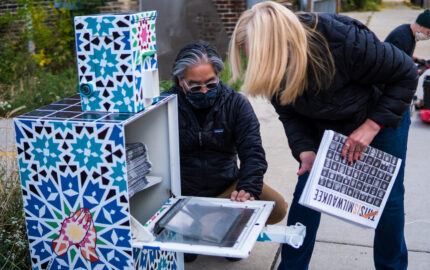If you’re looking for something to explain President-elect Donald Trump’s unlikely victory, the signs were everywhere this fall in Millinocket, a northern Maine mill town now without a mill. Trump/Pence signs, that is, often paired with “No on 3” signs, opposing a gun control measure on Maine’s ballot. (It failed).
It’s a region in economic despair. Paper mills in Millinocket and East Millinocket once employed thousands. Now they are moldering hulks, stripped of their assets, even their scrap metal. Some houses in town cost less than $30,000.
In broadest terms, there are two Maines. There’s the thin strip along the coast—lobsters, lighthouses, craggy shores—where you’ll find most of the state’s people, jobs and wealth. Then there’s the other Maine, the potato farms of Aroostook County, and the vast industrial forests that cover nearly two-thirds of the state.
Northern Maine is a land apart, surrounded on three sides by Canada. And yes, it’s flyover country—Americans en route from Boston or New York to London or Paris can glance down and see that sea of green, looking idyllic from 30,000 feet. This other Maine is roughly defined by Maine’s Second Congressional District, so sparsely populated it’s the largest congressional district east of the Mississippi.
Maine has a long tradition of bipartisanship, electing mostly centrist politicians from both sides of the aisle to state and national office. The more affluent coast typically votes Democratic. The more rural northern areas have typically trended Republican. But, until recently, there were very significant exceptions—the mill towns were reliably blue.
When the pulp and paper mills employed thousands of Mainers, their labor unions were powerful pistons in Maine’s Democratic machine. The unions provided well-paying jobs, and the mill workers provided the votes. But those jobs are mostly gone now.
In this, Donald Trump saw opportunity. He visited Maine five times during the campaign, and held a rally in Lisbon, in Maine’s Second Congressional District, last month as the campaign was in its final weeks.
Up in Millinocket, there aren’t many voters left; the town has lost nearly half its residents over the last 20 years. In 2012, 1,317 voted for President Obama and 937 for Mitt Romney. This time, that number flipped: Just 913 of them voted for Clinton, who won the statewide vote. But 1,161 voted for Trump, who prevailed in the Second Congressional District, earning its single electoral vote. It’s a subtle shift that is significant because the same thing happened in economically depressed rural areas nationwide, with profound political consequences.
It’s hard to say what changed in four years, Millinocket had already fallen on hard times in 2012. But if you turned up the squelch knob and tuned out the clamor of the divisive campaign, you would have heard one candidate speaking out forcefully on behalf of American workers, and their jobs. Voters in northern Maine heard that message loud and clear.
Millinocket’s story is neither unique nor new. I remember visiting the central Maine town of Corinna in late 1999, reporting a story for The Boston Globe. A woolen mill had gone bankrupt, putting 300 people out of work. It left a legacy of pollution, and the river flowing through town was a Superfund site.
Locals were angry about the pollution, and the mill closing. But they were also nostalgic about the town’s heyday in the 1960s, when it had a cannery, a rolling rink, a bowling alley, a train station, lunch counters, and hardware and grocery stores. “You could hear the looms running all night, clicketa, clicketa,” a selectmen told me. “The mill offered opportunities for every kid in town if they wanted to work.”
Thinking back over two decades of reporting, I realize how consistently I’ve heard similar accounts of a lifestyle lost. The nostalgia for the thrum and buzz of a thriving town with a noon whistle. The fond memories of graduating from high school, then walking to the mill to sign up for a job. I’d be lying to say these vignettes allowed me to predict Trump’s victory, but they sure do provide the context for understanding it.



